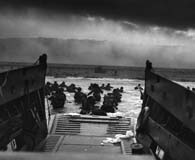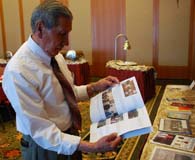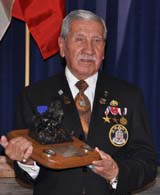A Quiet Hero: The Saga of Charles Norman Shay

Recently, I attended a conference on World War II in New Orleans hosted by the National World War II Museum, where I was privileged to moderate a panel on D-Day. On the panel were two great American patriots, both combat veterans of that momentous event. One was a paratrooper of the 101st Airborne Division who parachuted into Normandy on D-Day. His profile will appear in a forthcoming article.
The other was retired Master Sergeant Charles Norman Shay, a tribal elder and a member of the Penobscot tribe of Indian Island, Maine – one of four brothers who served during World War II.
{default}On D-Day 1944, Charles Shay was one of over five hundred North American Indian soldiers who landed on the beaches of Normandy. These men represented a number of American and Canadian tribes. Shay served in the 1st Infantry Division, the Big Red One. He was only nineteen years old and was a recently drafted combat medic.
Shay was assigned to an assault platoon in the 16th Regiment, and was part of the first wave that landed on June 6 on bloody Omaha Beach under very heavy German fire. The Big Red One sustained about 2,000 casualties on D-Day; most were sustained during the first hour of the landings. Many of the wounded were treated by Charles Shay.
 His actions on Omaha Beach on D-Day speak volumes about this modest, humble man. "Blood stained the water red,” he later recalled. There were countless men dead or dying in the rising tide. Armed with only his two satchels of medical supplies, he sought refuge behind a sand dune where he began tending to those who were mortally wounded. Looking seaward, Shay saw wounded men struggling to get ashore loaded down with equipment who were drowning. With utter disregard for his own safety, he braved a barrage of fire to pull wounded soldiers to the shelter of a sand dune where he treated them.
His actions on Omaha Beach on D-Day speak volumes about this modest, humble man. "Blood stained the water red,” he later recalled. There were countless men dead or dying in the rising tide. Armed with only his two satchels of medical supplies, he sought refuge behind a sand dune where he began tending to those who were mortally wounded. Looking seaward, Shay saw wounded men struggling to get ashore loaded down with equipment who were drowning. With utter disregard for his own safety, he braved a barrage of fire to pull wounded soldiers to the shelter of a sand dune where he treated them.
His heroic actions that morning earned him the Silver Star. His citation reads: “The President of the United States of America, authorized by Act of Congress, July 9, 1918, takes pleasure in presenting the Silver Star to Private Charles Norman Shay (ASN: 31308724), United States Army, for gallantry in action while serving as a Medical Aidman in the 1st Infantry Division, in action in the vicinity of Colleville-sur-Mer, Normandy, France, on 6 June 1944. Subordinating personal safety to the welfare of his comrades, Private Shay repeatedly plunged into the treacherous sea and carried critically wounded men to safety. Private Shay’s unselfish heroism exemplified the finest traditions of the Medical Department.”
Although he was miraculously never wounded, seven other medics from his regiment were killed on D-Day and twenty-four others wounded. “Being a combat medic is a very special privilege. I have always been proud to be a medic and I felt that I was doing something good for other people,” Shay has said. To this day he still gets emotional when speaking of the friends and fellow soldiers who were lost in combat. Like virtually all soldiers who have survived combat, Shay has pondered how he did so unscathed. “I am a great believer in a spiritual way of life,” he said, “and I know that my mother’s prayers must have guided me.”
 He also saw action with the Big Red One during the siege of Aachen, the Battle of the Huertgen Forest and the Battle of the Bulge. After crossing the Rhine at Remagen Bridge in 1945 Shay was captured but survived the POW camps.
He also saw action with the Big Red One during the siege of Aachen, the Battle of the Huertgen Forest and the Battle of the Bulge. After crossing the Rhine at Remagen Bridge in 1945 Shay was captured but survived the POW camps.
After returning to the Penobscot reservation in 1945, he reenlisted and served in occupied Austria and then returned to combat as a medic in Korea, where he was awarded the Bronze Star with two Oak Leaf clusters for valor for again saving lives. This was followed by a stint in the southern Pacific where atomic bombs were tested. He also served in the Air Force before retiring in 1954 as a master sergeant.
For most of the next forty-five years Shay worked in Vienna for the International Atomic Energy Commission and later for the United Nations High Commissioner of Refugees before returning to his native Maine and a well-earned retirement.
Three Penobscot soldiers died in the war. Shay and his three brothers were among the eighty or so Penobscots — nearly every eligible male at Indian Island–who served in the Pacific, African, and European theaters of World War II.
On June 6, 2007, Governor John Baldacci of Maine honored Charles Shay and other Native Americans by proclaiming it Native American Veterans History Day in the State of Maine. What Gov. Baldacci said that day bears repeating: “Native Americans – like many other Americans – have contributed greatly in service to their country over many decades. Unfortunately the part they have played in protecting their country has been neglected. We are here today to issue public recognition that is long overdue.”
Much like our disgraceful treatment of black soldiers during the war, the United States saw fit to draft Native Americans but did not see fit to permit them the fundamental right to vote. During World War I an estimated 12,000 American Indians served in our armed forces, where they fought defending a nation that had yet to grant them the basic right of citizenship. In 1919, Congress enacted legislation that belatedly granted citizenship to World War I veterans but other Native Americans only became citizens in 1924.
 In the years that followed some states granted Native Americans voting rights while others threw up legal roadblocks and used ruses to deny them the right to vote. Many were Western states but the last state to finally grant them this right was Maine, in 1954, when its two recognized tribes were permitted to vote in national elections. However, it took until 1967 before Maine granted them the right to vote in state and local elections. Maine, however, remains the only state that has non-voting tribal members in its legislature – a single Penobscot and one Passamaquoddy. As Shay has said, “We were second class citizens in our own country. However, we served this country faithfully, but in effect we were fighting to protect our own land. I therefore find it very appropriate that the Maine State Legislature passed the bill LD 30 establishing June 21 as Native American Veterans Day in the State of Maine.” (Maine Indian Tribal-State Commission article, 2010)
In the years that followed some states granted Native Americans voting rights while others threw up legal roadblocks and used ruses to deny them the right to vote. Many were Western states but the last state to finally grant them this right was Maine, in 1954, when its two recognized tribes were permitted to vote in national elections. However, it took until 1967 before Maine granted them the right to vote in state and local elections. Maine, however, remains the only state that has non-voting tribal members in its legislature – a single Penobscot and one Passamaquoddy. As Shay has said, “We were second class citizens in our own country. However, we served this country faithfully, but in effect we were fighting to protect our own land. I therefore find it very appropriate that the Maine State Legislature passed the bill LD 30 establishing June 21 as Native American Veterans Day in the State of Maine.” (Maine Indian Tribal-State Commission article, 2010)
What Charles Shay modestly did not mention was that he was the inspiration for the enactment of this legislation.
During World War II 44,000 Native Americans enlisted in the Armed Forces; two received the Medal of Honor, 51 earned the Silver Star, 34 the Distinguished Flying Cross. They also earned 47 Bronze Stars and 71 Air Medals.
In 2007, Charles Shay revisited Omaha Beach and other World War II battlefields for the first time. Also in 2007, during his first official visit to the United States, French President Nicholas Sarkozy honored seven American veterans of World War II with the Légion d’Honneur. One of them was Charles Shay.
He is one of America’s finest native sons.
Later this year his biography will be published. It is called “From Indian Island to Omaha Beach: The Story of Charles Shay, Penobscot Indian War Hero”
For more about Charles Shay, click here to read Patricia Erikson’s blog.
Quotes about Omaha Beach from the army.mil article "Native American Indian Heritage Month brings history, tradition to Fort Sam."


Charles Norman Shay was really a hero. I saluted such a great human.
Thank,
Simmon
Furnicons ltd
Wow what a true American patriot. I’m touched by this man’s actions and stories. I simply cannot respect anyone as much as I do of these WW2 veterans for the heroics and situations they’ve been put thru. True American pride. Thank you for all that you’ve endured and given.